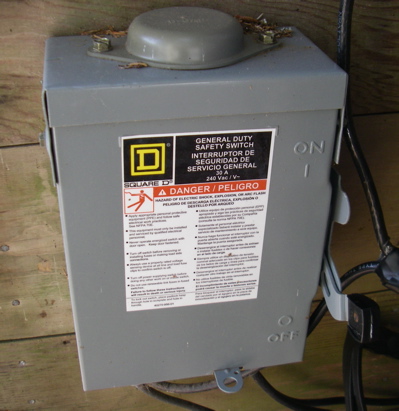How sunny has it been lately? Thursday, just before the local Vernal Equinox, which falls today, I cut incoming power from the solar panels for a while!
The most basic goal of our off-the-grid system is to charge the battery bank to 100% as often as possible, and keep there for as long as we can. We obviously use the power we need, but keeping this goal in mind ensures that we have the power to use, and maintains the “health” of the batteries.

"Igor, throw the switch!" The fuse box that controls electricity coming in from the solar panels. The Big Switch flipped to "Off" (Photo: Mark Zeiger).
The best way to reach this goal with a system that uses both wind and solar power is to balance the two. The wind generator creates far more power than the solar panels for a longer period, so we rely on it to restore the power we’ve used to as close to 100% as we can. Once that point is reached, we tend to turn off the wind generator and allow the smaller, steadier solar charge to “top off” the batteries to full charge. This is called a trickle charge. It creates a more thorough charge because of the nature of lead acid batteries. Their voltage rises sharply in response to incoming charge, then levels off to a lower voltage after the charging stops. Tapering the charge down and down to next to nothing fully charges the batteries.
A simple analogy: you want your bucket filled so full that surface tension bulges above the rim. You can fill most of the bucket with a garden hose, but to top it off to surface tension level, you need to reduce the water flow down to a bare trickle for the last little bit.
The amount of charge from either of these sources is regulated by the charge controller. If the incoming electricity exceeds set levels of initial voltage in the battery bank, the controller cuts the charge until voltage falls below a minimum set point. To do this, it “regulates” the wind generator, signalling it to stop producing power until the set point is reached, when it starts up again. The solar panel controller tapers incoming power off until its set point is reached.
Regulation has caused the problem we’ve experienced the last few days. Our “solar window” has been bringing in as much as 5 amps of solar, enough to trigger the wind generator’s regulation. The smaller charge then holds the larger charge at bay, never allowing the lower set point to be reached. When the sun passes behind the ridge, and solar charge decreases, the wind generator starts up again. It may reach 100%, but it can’t be topped off. Since this coincides with the evening’s increased power usage, we may not reach 100% at all.
To solve this, I’ve had to go out and turn the solar array fuse box off, cutting off incoming solar charge until the wind generator can charge the batteries up to 100%. Once that’s accomplished, I turn the panels back on, and allow the two to balance each out as long as the sun lasts, giving us the necessary trickle charge to reach 100% (even higher—103% sometimes) as it should.
This little maneuver strikes me as extremely ironic. Here in “rainy Southeast Alaska” the idea of cutting out one’s solar panels because they’re charging too much seems laughable, but it appears to be necessary under certain conditions. It’s encouraging that we’re facing this “problem” before our daylight and darkness equalize. We’re getting “too much” solar on a mere half day of sunlight. After today, as the daylight lengthens until we have more than 18½ hours at the summer solstice, bodes well for our energy “harvest.” True, we’ll have many, many days when we don’t have enough sunshine or wind to do everything we’d like with the battery bank. We will have to cut back on some activities on some days, but we always have enough for our essential needs.

I don’t live like you but I have always been able to “rig” just about anything (and worked in the electrical field for years:). So I can relate to what you do. I kinda have a love/hate relationship with my “rigging” abilities (which I owe greatly to my Dad).
Roger, it’s never dull, though, is it?